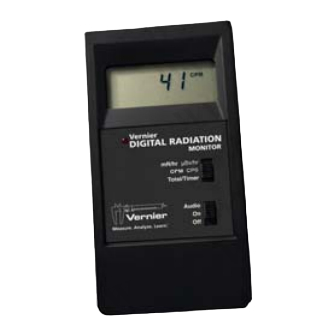Table of Contents
Advertisement
Quick Links
Digital Radiation Monitor
(Order Code DRM-BTD)
Contents
1 Introduction ............................................................................................................. 2
How the DRM Detects Radiation ................................................................. 2
2 Features ................................................................................................................... 3
The Display................................................................................................... 3
The Switches ................................................................................................ 4
The Detector.................................................................................................. 5
The Ports ....................................................................................................... 5
3 Operation................................................................................................................. 6
Units of Measurement................................................................................... 6
Starting the Digital Radiation Monitor.......................................................... 6
Operating Modes........................................................................................... 6
Taking a Timed Total Count ......................................................................... 6
Operating Ranges and Response Times ........................................................ 7
The Utility Menu........................................................................................... 8
Interfacing to an External Device ................................................................. 9
4 Common Procedures ............................................................................................... 9
Establishing the Background Count.............................................................. 9
Environmental Area Monitoring ................................................................. 10
Checking an Object..................................................................................... 10
5 Maintenance .......................................................................................................... 10
Calibration................................................................................................... 11
Precautions.................................................................................................. 11
Troubleshooting ......................................................................................... 11
6 Basics of Radiation and Its Measurement ............................................................. 12
Ionizing Radiation....................................................................................... 12
Measuring Radiation ................................................................................... 14
Radiation Measurement Units..................................................................... 14
Higher Than Normal Readings ................................................................... 15
Appendix A Technical Specifications ....................................................................... 16
Warranty.................................................................................................................... 17
1 Introduction
The Digital Radiation Monitor is a health and safety instrument that measures alpha,
beta, and gamma radiation. With the Digital Radiation Monitor, you can:
•
Monitor possible radiation exposure while working near radionuclides
•
Ensure compliance with regulatory standards
•
Check for leakage from X-ray machines and other sources
•
Screen for environmental contamination or environmental sources of
radioactivity
•
Connect the Digital Radiation Monitor to a computer or data logger to record
and tabulate your data
This manual gives complete instructions for using the Digital Radiation Monitor and
procedures for common applications.
How the Digital Radiation Monitor Detects Radiation
The Digital Radiation Monitor uses a Geiger-Mueller tube to detect radiation. The
Geiger tube generates a pulse of electrical current each time radiation passes through
the tube and causes ionization. Each pulse is electronically detected and registers as
a count. The Digital Radiation Monitor displays the counts in the mode you choose:
counts per minute (CPM), milliroentgens per hour (mR/hr), or total counts for a
timed period. In SI units, counts per second (CPS) and microsieverts per hour
(μSv/hr) are used.
2
Advertisement
Table of Contents

Summary of Contents for Vernier DRM-BTD
-
Page 1: Table Of Contents
Digital Radiation Monitor beta, and gamma radiation. With the Digital Radiation Monitor, you can: • Monitor possible radiation exposure while working near radionuclides (Order Code DRM-BTD) • Ensure compliance with regulatory standards • Check for leakage from X-ray machines and other sources Contents •... -
Page 2: Features
2 Features The Display The Digital Radiation Monitor measures alpha, beta, gamma, and x-ray radiation. Several indicators on the LCD show information about the mode setting, the current This chapter briefly describes the Digital Radiation Monitor's functions. For more function, and the battery condition. information on how to use the Digital Radiation Monitor, see Chapter 3, "Operation."... -
Page 3: The Detector
Mode Switch (5) mR/hr μSv/hr. The LCD shows the current radiation level in milliroentgens per 3 Operation hour from 0.001 to 110 or, when SI units are used, in microsieverts per hour The guidelines in this chapter describe how to use the Digital Radiation Monitor. from 0.01 to 1100. -
Page 4: Operating Ranges And Response Times
Taking an average allows you to detect low-level contamination or differences in Maximum level. When the maximum level for the current mode is reached, the background radiation due to altitude or soil mineral content. For example, if one Digital Radiation Monitor beeps for three seconds, pauses for three seconds, and 10 minute average is one count higher than another 10 minute average, the increase repeats that pattern. -
Page 5: Interfacing To An External Device
Cal 100 Reset. Automatically resets the calibration factor to 100 and restarts the Environmental Area Monitoring instrument. You can keep the Digital Radiation Monitor in CPM or mR/hr mode whenever you want to monitor the ambient radiation, and look at it from time to time to check for 4, 5, 6 Reserved for future options. -
Page 6: Precautions
The Geiger tube needs to be be working properly, look through the following chart to see if you can identify the replaced problem. If the Digital Radiation Monitor requires servicing, please contact Vernier electro-magnetic field Move the instrument away from Software &... -
Page 7: Measuring Radiation
Ionizing radiation is categorized into four types: The following chart shows the complete decay chain for Uranium 238, which ends with a stable isotope of lead. Notice that the half-life of the radionuclides in the X-rays are usually manmade radiation produced by bombarding a metallic target chain range from 164 microseconds to 4.5 billion years. -
Page 8: Radiation Measurement Units
Radiation Measurement Units Different units are used to measure radiation, exposure to radiation, and dosage. Appendix A Technical Specifications A roentgen is the amount of X-radiation or gamma radiation that produces one Sensor: Halogen-quenched Geiger-Mueller tube with mica electrostatic unit of charge in one cc of dry air at 0° C and 760 mm of mercury end window (LND 712 or equivalent). -
Page 9: Warranty
• www.vernier.com Rev. 1/31/08 Logger Pro, Vernier LabPro, and other marks shown are our registered trademarks in the United States. CBL 2, TI-GRAPH LINK, and TI Connect are trademarks of Texas Instruments. All other marks not owned by us that appear herein are the property of their respective owners, who may or may not be affiliated with, connected to, or sponsored by us.

















Need help?
Do you have a question about the DRM-BTD and is the answer not in the manual?
Questions and answers